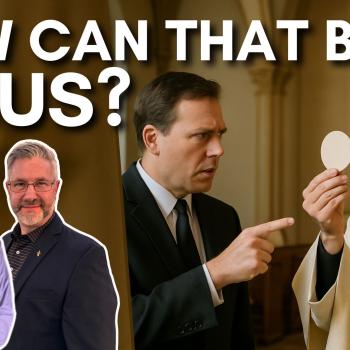Again Bernadette was questioned, and annoyed officials redoubled their efforts to frighten her into recanting. Again, she stuck to her story. Two days later, Bernadette returned to the grotto and drank from the spring. On March 1, a local woman whose fall from a tree had left her with a permanently crippled arm, went to the spring and plunged her arm in the water. In a few moments her bent fingers straightened and the arm was healed. It would be the first of the many miracles attributed to the spring at Lourdes.
Interest over Bernadette's vision continued to mount, and by the time of the 13th apparition, Bernadette was accompanied by over 1,500 people. After this apparition she raced to Abbé Peyramale, to tell him what the vision had said to her: "Go, tell the priests to come her in procession and build a chapel here." As René Laurentin notes in Bernadette of Lourdes, the alarmed priest was appalled, imagining the opprobrium that would descend on him if he were to authorize a ridiculous request from a poor young girl. So the practical Peyramale demanded some answers from the vision. Ask her for a name, he said bluntly. And, as an added test, ask her to make the wild rose bush in the grotto to flower.
During the next apparition, Bernadette did just that, but the vision merely smiled. No rose bushes bloomed and no names were given. The priest told her again. "If the lady really wishes that a chapel be built, she must tell us her name and make the rose bush bloom."
On March 25, the rose bush was still not in bloom, but a name was given. According to Bernadette, the vision clasped its hands and said, "Que Soy Era Immaculada Concepciou." I am the Immaculate Conception. Bernadette, whose religious training was rudimentary at best, had no idea what this meant. She kept repeating the phrase over and over, lest she forget it, as she rushed to Abbé Peyramale.
The film's depiction of her meeting with her pastor corresponds well to what happened next. Charles Bickford, as Abbé Peyramale, questions Bernadette severely. "The Immaculate Conception," he demands. "Do you know what that means?"
Jennifer Jones shakes her head.
He explains (in reality he writes this in a letter to the bishop) that the name is nonsensical. A few years before, the doctrine of the Immaculate Conception had been proclaimed by the Vatican, holding that the Virgin Mary had been conceived without the stain of original sin. But to say, "I am the Immaculate Conception" was ridiculous. Like saying not "I am white," but "I am whiteness." But both the movie Bernadette and the real one stuck to their stories.
After this there came two more apparitions, and by the time of the final one, the police had boarded up the front of the grotto to prevent any gatherings of the faithful. On July 16, on the feast of Our Lady of Mount Carmel, Bernadette was forced to view the grotto from across the Gave River. But no matter. "I saw neither the boards nor the Gave," she said. "It seemed to me that I was in the Grotto, no more distant than the other times. I saw only the Holy Virgin."
With this final apparition, Bernadette's life changes once again. Greatly admired, hounded by the faithful, and even pressed to perform miracles in her hometown (she resists, of course), Bernadette becomes the object of fascination for increasing numbers of pilgrims. In 1860, partially to escape her growing fame and partially to receive more of a formal education, she enters a small convent school in Lourdes. But her candor and straightforward attitude remain. In 1861 she is photographed for the first time, and urged by the photographer adopt the precise pose and expression that she had during the apparitions. "But she isn't here," Bernadette protests.
A few years later, at age 22, she enters the convent of the Sisters of Charity in Nevers, hundreds of miles from Lourdes. Before leaving, she pays a last visit to her beloved grotto. "My mission in Lourdes is finished," she says.
Even in the convent, Bernadette is reluctant to discuss her experiences. She tells the story of the apparitions only twice to her community, hoping in vain to "hide" herself among her sisters. Always sickly from her childhood asthma, Bernadette is unable to assume many of the tasks of the other sisters, and even finds it difficult to pray. "Oh dear," she says, "I don't know how to meditate." Nonetheless, she is a cheerful person, even in the face of illness, always teasing and laughing with her sisters. In the infirmary one day, she takes to embroidery, favoring patterns of small hearts. "If someone tells you that I have no heart," she jokes, "tell them I make them all day long."
Gradually, she weakens and is increasingly confined to her bed. A cancerous tumor is discovered on her leg, and she declines rapidly. On her deathbed, her mind returns to Massabieille. "I have told the events," she tells her sister. "Let people abide by what I said the first time. I may have forgotten and so may others. The simpler one writes, the better it will be." At her death, Bernadette is 34 years old.




